Strawberries (Fragaria × ananassa) are among the most cherished fruits worldwide, known for their sweet, tangy flavor, vibrant color, and versatility in gardens, containers, and farms alike. Whether you’re growing a single pot on your balcony or cultivating a backyard patch, one of the most crucial factors that determine the success of your strawberry harvest is proper watering.
Watering too little can result in small, dry, or bitter berries, while overwatering can lead to root rot, fungal diseases, and poor fruit quality. So, how often should you water a strawberry plant? The answer depends on several factors: plant age, growth stage, soil type, climate, and whether the plant is in a pot or in the ground.
In this detailed article, we’ll explore the ideal watering schedule for strawberry plants, the amount of water they need, seasonal watering adjustments, and common mistakes to avoid — giving you everything you need for a thriving, fruit-filled strawberry patch.
Why Is Watering Important for Strawberry Plants?
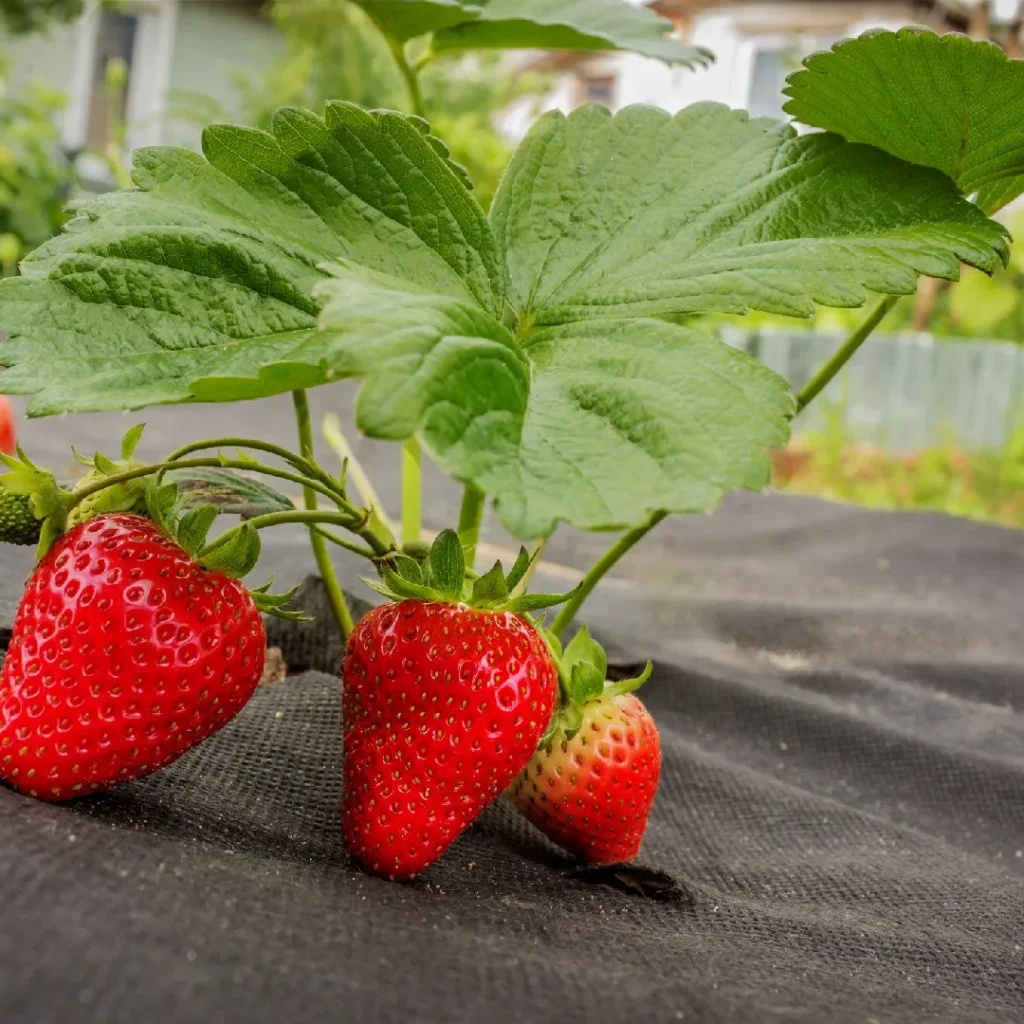
Strawberry plants rely on a consistent, balanced supply of moisture for several vital processes:
- Supports photosynthesis and nutrient transport.
- Promotes healthy leaf, flower, and fruit development.
- Prevents problems like wilting, leaf scorch, fruit deformities, and poor flavor.
- Reduces plant stress, making them less vulnerable to pests and diseases.
Since strawberry plants have shallow root systems (typically within the top 6 inches of soil), they are particularly sensitive to soil moisture fluctuations and require careful, consistent watering.
How Often Should You Water a Strawberry Plant?
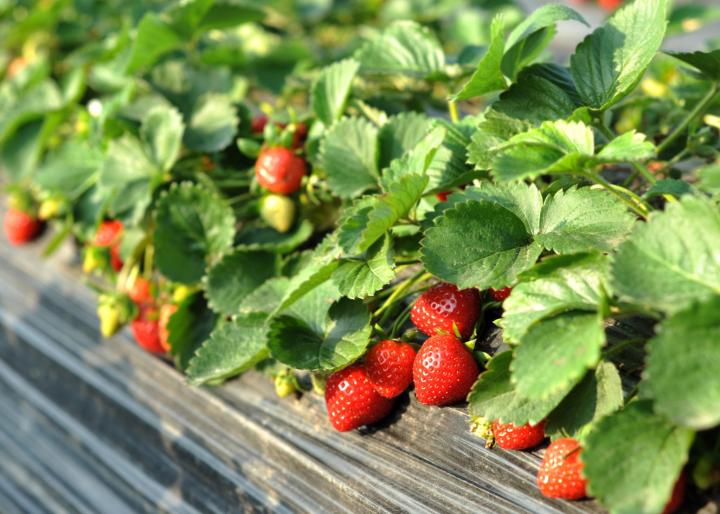
The frequency of watering strawberry plants varies based on their stage of growth, local weather, and soil conditions.
| Plant Stage | Watering Frequency |
|---|---|
| Newly planted runners or seedlings | Every 1–2 days until well established (2–4 weeks) |
| Actively growing plants (spring & early summer) | Every 2–3 days or as needed in dry weather |
| Flowering and fruiting season | Every day or every other day in warm weather |
| Mature plants (post-harvest, cooler months) | Every 4–7 days depending on rainfall and soil |
| Dormant plants (winter, if applicable) | Water occasionally if soil is dry |
Seasonal Watering Needs for Strawberries
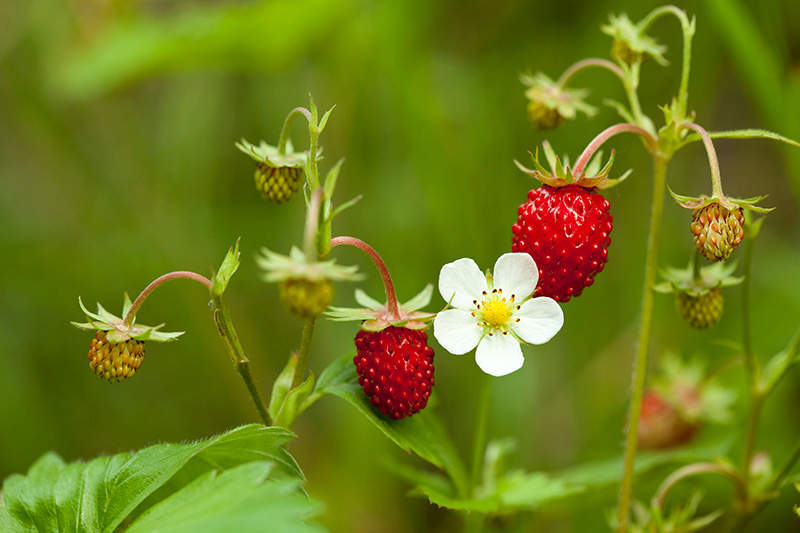
Spring
- As plants awaken from dormancy, new leaves, runners, and flowers appear.
- Water 2–3 times a week, increasing during dry or windy spells.
- Maintain even soil moisture to encourage steady growth.
Summer
- Peak flowering and fruiting season for most strawberry varieties.
- Water daily or every other day in hot, dry weather.
- Soil should remain consistently moist (but not waterlogged) to prevent fruit shriveling and bitterness.
- Container plants may need daily watering or more during heatwaves.
Autumn
- Growth slows after fruiting. Watering can be reduced.
- Water every 4–7 days, depending on rainfall and soil type.
- Avoid allowing soil to completely dry out, especially for newly set runners preparing for next season.
Winter
- In mild climates, strawberries remain semi-active. In cold areas, they go dormant.
- Water only when soil is dry, about once every 2–3 weeks if no natural rainfall occurs.
- Avoid waterlogging during cold, damp weather.
How Much Water Does a Strawberry Plant Need?
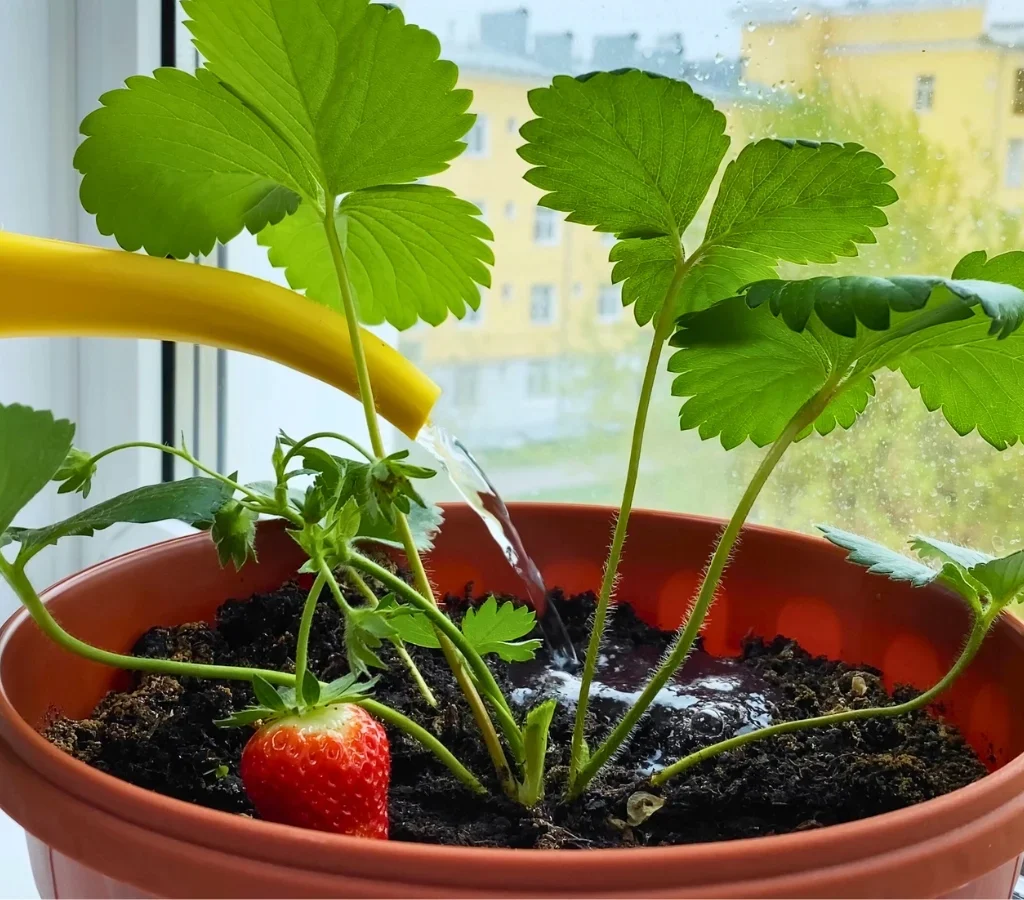
Strawberry plants require about 1–1.5 inches (25–38 mm) of water per week, depending on heat and soil conditions.
General Guidelines:
- Newly planted seedlings: 0.5–1 liter (0.13–0.26 gallons) per plant every 1–2 days.
- Established plants: 1–2 liters (0.26–0.53 gallons) per plant per session in dry weather.
- During fruiting: Maintain consistent moisture, adjusting for rainfall.
Deep watering is ideal — water should soak the soil to a depth of 6 inches where the roots reside.
Watering Strawberry Plants in Containers
Potted strawberry plants dry out faster than those in the ground.
Container care tips:
- Check soil moisture daily in warm weather.
- Water when the top 1–2 inches of soil feel dry.
- Ensure containers have proper drainage holes.
- Avoid letting pots sit in standing water.
In summer, containers may require watering once or twice a day.
How Soil Type Affects Watering Frequency
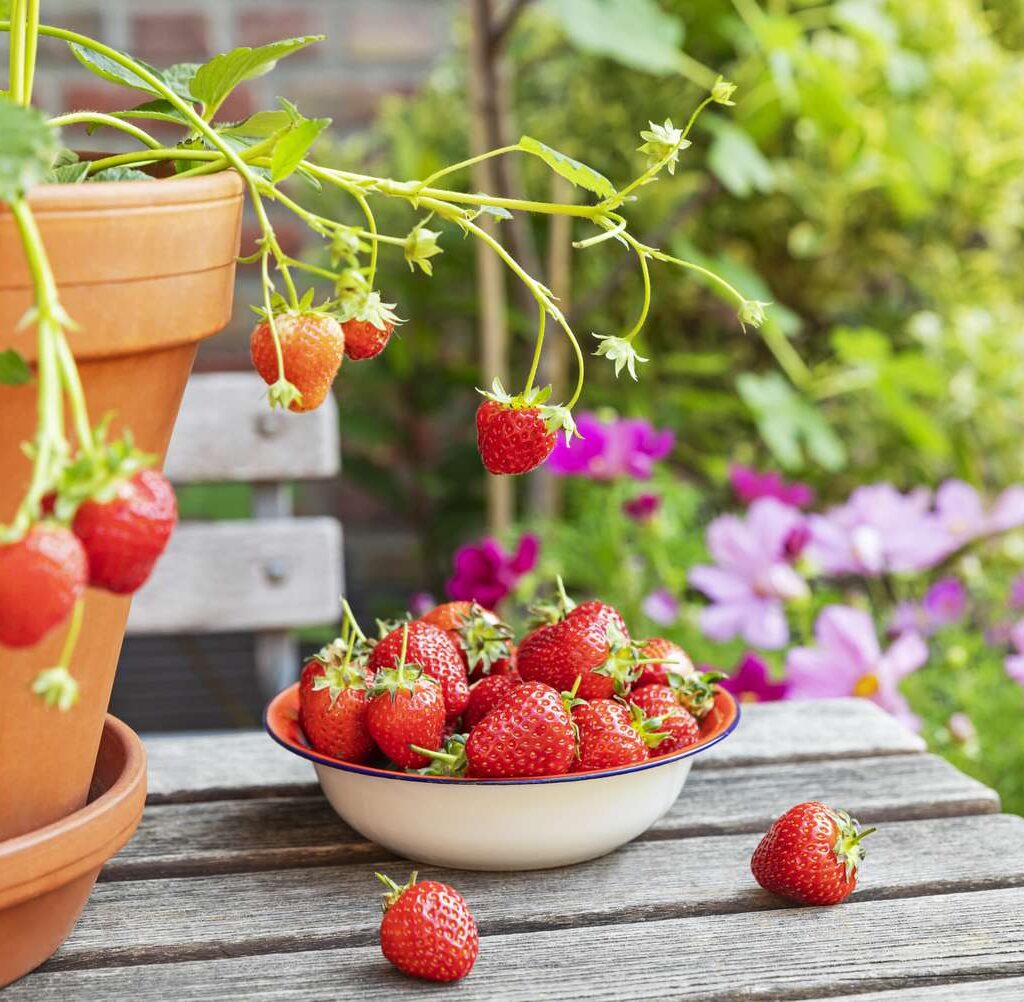
Different soil types hold and release water at different rates:
| Soil Type | Watering Frequency |
|---|---|
| Sandy soils | Drain quickly; water more frequently |
| Loamy soils | Retain moderate moisture; ideal |
| Clay soils | Hold water; water less often, ensure drainage |
Ideal soil: A well-draining, loamy, and organic-rich soil with good moisture retention and aeration. Raised beds or mounded rows improve drainage for strawberries.
Climate and Weather Considerations
In hot, dry, or windy climates:
- Increase watering frequency during heatwaves.
- Use mulch (like straw or pine needles) to conserve soil moisture, suppress weeds, and keep fruits clean.
In humid, rainy climates:
- Reduce watering, check soil before each session.
- Avoid overwatering to prevent root rot and fungal issues.
Best Time of Day to Water Strawberry Plants
The optimal time to water strawberries is:
- Early morning: Allows foliage to dry during the day, reducing fungal disease risk and ensuring efficient water absorption.
- Late afternoon: If necessary, but avoid late evening watering.
Benefits of Mulching Strawberry Beds
Mulching provides multiple benefits:
- Reduces moisture loss by preventing evaporation.
- Keeps soil temperature stable.
- Keeps fruits off soil, reducing rot.
- Suppresses weeds.
- Improves soil quality as it decomposes.
Recommended mulch materials:
- Clean straw
- Pine needles
- Shredded bark
- Dry leaves
Apply a 2–3 inch thick layer, keeping mulch away from the plant crown to prevent rot.
Signs of Overwatering and Underwatering
Signs of Underwatering:
- Wilting or dry leaves.
- Small, dry, and shriveled berries.
- Brown, crispy leaf edges.
- Slow plant growth and poor runner formation.
Signs of Overwatering:
- Yellowing leaves.
- Soft, rotting fruit.
- Fungal problems like root rot and mildew.
- Persistent wet soil with a sour smell.
Tip: Check soil moisture with your finger or a moisture meter 2–3 inches deep — water only when it feels dry.
Common Watering Mistakes to Avoid
| Mistake | Effect | Solution |
|---|---|---|
| Frequent, shallow watering | Shallow roots, weak plants | Water deeply and evenly |
| Watering overhead during midday heat | Increases evaporation and sunscald risks | Water early morning |
| Ignoring soil type and weather | Uneven moisture, plant stress | Adjust watering based on soil and season |
| Overwatering during rainy periods | Root rot, fungal issues | Water only when necessary |
When to Reduce or Stop Watering Strawberry Plants
After fruit harvest:
- Gradually reduce watering as plants slow growth.
- Water during dry spells to support late runner establishment.
In winter dormancy:
- Water only if soil is dry for several weeks.
- Avoid waterlogged, cold soil that can damage roots.
Conclusion
Watering is a vital element in growing healthy, fruitful strawberry plants. By adjusting your watering schedule according to the plant’s age, season, soil type, and climate, you can encourage vigorous growth, abundant flowering, and a bumper harvest of juicy berries.
Focus on consistent, deep watering during flowering and fruiting seasons, reduce irrigation after harvest, and use mulch to maintain soil moisture. Monitor soil damTools




Leave A Comment